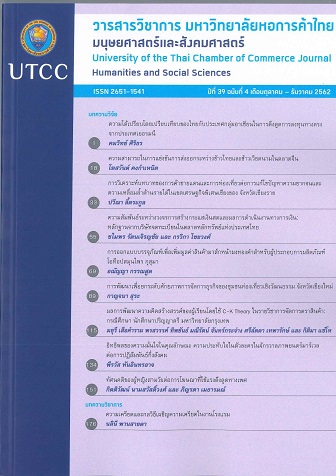An Analysis of Border Trade and Tourism Roles for Alleviation of Poverty and Income Inequality in Chiang Khong Special Economic Zone of Chiang Rai Province
Main Article Content
Abstract
The objectives of this study were to analyze the border trade and tourism roles for alleviation of poverty and income inequity in Chiang Kong special economic zone of Chiang Rai province. This mixed-method study employed an interview with 653 households. The results showed that the households performing border trade career showed lower poverty ratio than those households performing agriculture and tourism careers. The results on income inequity analysis of the households indicated the Gini index at 0.4398 which was higher than the mean score of Thailand. The households performing the career related to border trade held the highest income inequity while the households performing tourism career held the lowest income inequity. The results from the econometric model revealed that the border trade and tourism roles showed no statistically significant relationship with escaping from poverty and income inequality. However, the factors promoting an escape from poverty and income inequality was education, jobs in formal sector, household dependency, economic welfare, and household saving. Nevertheless, the households in trade and tourism potential area tended to survive from poverty at 95% significance level. These findings lead to policy implication that the government should create border trade and tourism activities and expand the area of tourism promotion in Chiang Khong Special Economic Zone. Besides, the government and related agencies should focus on promoting the jobs in formal sector, reducing household dependency, increasing household saving so that would encourage poverty reduction and income inequality simultaneously
Article Details
ลิขสิทธิ์ของบทความ
ผลงานที่ได้รับการตีพิมพ์ถือเป็นลิขสิทธิ์ของมหาวิทยาลัยหอการค้าไทย ห้ามมิให้นำเนื้อหา ทัศนะ หรือข้อคิดเห็นใด ๆ ของผลงานไปทำซ้ำ ดัดแปลง หรือเผยแพร่ ไม่ว่าทั้งหมดหรือบางส่วนโดยไม่ได้รับอนุญาตเป็นลายลักษณ์อักษรจากมหาวิทยาลัยหอการค้าไทยก่อน
References
กลุ่มงานยุทธศาสตร์และข้อมูลเพื่อการพัฒนา. (2562). แผนพัฒนาจังหวัดเชียงราย 5 ปี (พ.ศ. 2561-2565) ฉบับทบทวนพ.ศ. 2563. เชียงราย: สำนักงานจังหวัดเชียงราย.
กอบศักดิ์ ภูตระกูล. (2556). คุณภาพการเจริญเติบโตจากมิติการกระจายรายได้. สืบค้นเมื่อ 1 กรกฎาคม 2561, จาก https://www.bot.or.th/Thai/MonetaryPolicy/ArticleAndResearch/Pages/Symposium2556.aspx
ปวีณา ลี้ตระกูล, และณัฐสุชน อินทราวุธ. (2554) . บทบาทของการค้าชายแดนต่อการกระจายรายได้และความยากจนในจังหวัดเชียงราย.วารสารเศรษฐศาสตร์ธรรมศาสตร์, 29(3),1-34.
สถาบันระหว่างประเทศเพื่อการค้าและการพัฒนา. (2561). การพัฒนาการค้าระหว่างประเทศเพื่อขับเคลื่อนประเทศกำลังพัฒนาสู่เป้าหมายการพัฒนาที่ยั่งยืน กรณีศึกษากลุ่มประเทศ GMS: กลุ่มประเทศอนุภูมิภาคลุ่มแม่น้ำโขง. กรุงเทพฯ: ผู้แต่ง.
Bigsten, A., Kebede, B., & Shimeles, A. (2002). Growth and poverty in Ethiopia: Evidence from household panel surveys. World Development, 31(1), 87-106.
Cattarinich, X. (2001). Pro-poor tourism initiatives in developing countries: Analysis of secondary case studies. Retrieved July 12, 2018, from http://www.proporrtourism.org.uk
Fields, G. S., & Yoo, G. (2000). Falling labor income inequality in Korea’s economic growth: Patterns and underlying causes. Retrieved July 12, 2018, from http://digitalcommons.ilr.cornell.edu/articles/1107
Foster, J., Greer, J., & Thorbecke, E. (1984). A class of decomposable poverty measures. Econometrica, 52(3), 761-776.
Heintz, J., & Vanek, J. (2007). Employment, the informal sector, and poverty: Data and analytical challenges. Retrieved July 12, 2018, from http://www.wiego.org/sites/default/files/publications/files/ Heintz_Vanek_China-IndiaPovertyandEmployment.pdf
Khontaphane, S., Insisiangmay, S., & Nolintha, V. (2006). Impact of border trade in local livelihoods: Lao-Chinese border trade in Luang Namtha and Oudomxay Provinces. Vientiane, Laos: UNDP.
Krishna, P., Mitra, D., & Sundaram, A. (2010). Trade, poverty and the lagging regions of south Asia. Retrieved July 12, 2018, from http://www.nber.org/papers/w16322.pdf
Manna, R., & Reogoli, A. (2012). Regression-based approaches for the decomposition of income inequality in Italy, 1998-2008. Rivista di Statistical Ufficiale, 14(1), 5-18.
Nissanke, M., & Thorbeck, E. (2010). Globalization, poverty, and inequality in Latin America: Findings from case studies. World Development, 38(6), 797-802.
Panpiemras, J., Chalamwong, Y., & Bhuthong, P. (2007). Do location and border trade activity matter in the presence of cross-border economic integration? TDRI Quarterly Review, 22(2), 5-18.
Pavencik, N. (2017). The impact of trade on inequality in developing countries. Retrieved July 12, 2018, from https://www.kansascityfed.org/~/media/files/publicat/sympos/ 2017/Pavencik-paper.pdf
Ravallion, M. (2006). Looking beyond averages in the trade and poverty debate. World Development, 34(8), 1374-1392.
Spilimbergo A., Londono J. L., & Szekely, M. (1999). Income distribution, factor endowments, and trade openness. Journal of Development Economics, 59(1). 77-101.
Yamane, T. (1967). Statistics: An introductory analysis. New York: Harper & Row.


